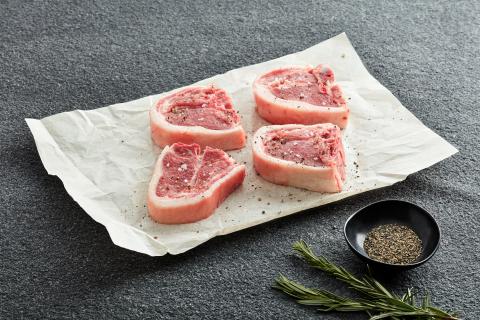
Exciting research has revealed hidden nutritional treasures within PGI Welsh Lamb, according to the sector’s largest ever lamb taste testing project.
Hybu Cig Cymru – Meat Promotion Wales (HCC) is seeking to shed new light on how farm and processing factors influence shoppers’ preferences through the Welsh Lamb Meat Quality Project.
The Project is part of a three-project, Welsh Government and EU funded Red meat Development Programme, that seeks to help Welsh farming prepare for an increasingly competitive global marketplace.
During the first scientific trials, three key factors were tested; type of cut, breed type and lamb gender. Results reveal that type of cut has the greatest impact on nutritional content.
Dr Eleri Thomas, HCC Meat Quality Executive, who leads the in-house taste programme team explains, “Polyunsaturated fat content (PUFA) was analysed and results show that of the three cuts tested - loin, chump and topside - the chump recorded the highest levels."
“PUFAs include Omega 3 and Omega 6 fatty acids which are essential for the diet and are considered healthy fats which are good for our well-being and for our hearts. It is suggested that the muscle cuts differed in polyunsaturated fat content depending on their biological role within the body."
“Interestingly, the analysis revealed that the breed of the lamb had no large effect on the major fatty acid groups.”
Alongside the nutritional analysis, consumer taste panels were also held across the UK to analyse the effect of breed type, cut and lamb gender on lamb eating quality. The consumer taste panels took place during January and February 2020 with 480 consumers tasting and rating seven pieces of lamb.
Consumers were asked to score the meat on the attributes of aroma, tenderness, juiciness, liking of flavour and an overall liking on a 0-100 line scale. It was found that again the type of meat cut had an impact on eating quality with consumers detecting a variation in eating quality between the muscle cuts, while there was no significant difference between breed or lamb gender.
Encouragingly, results showed that consumers, particularly younger groups, were willing to pay more for higher quality lamb.
The full report is available on HCC’s website: https://meatpromotion.wales/en/industry-projects/red-meat-development-programme/welsh-lamb-meat-quality/results
“Each year, the project will explore and analyse different on-farm and processing factors on the eating quality of lamb,” says Dr. Thomas. “Next year we will be investigating the effect of the lambs’ diet on the nutritional quality and its taste and flavour. There will be a sharpened focus on lambs that have been nurtured on different diets such as grass, fresh roots (like turnips) and brassicas (like kale).”
The Welsh Lamb Meat Quality project is supported by the Welsh Government Rural Communities – Rural Development Programme 2014-2020 and funded by the European Agricultural Fund for Rural Development and the Welsh Government.


